2022 Annual BNAC Newsletter
Each year, we share highlights of our patient-centered research, news about our scientists, core laboratory services, and our many collaborations at the Buffalo Neuroimaging Analysis Center. Thank you for taking an interest in our work. As always, we welcome your inquiries, comments, and suggestions and invite you to stay in touch with our progress on the developments that matter most to you.
LINDA J. SAFRAN, CFRE, MARKS 14 YEARS OF EXTRAORDINARY SERVICE TO BNAC AND PEOPLE WITH MS
Smart. Creative. Indefatigable. Optimist. There certainly are more ways to describe BNAC’s long-time friend and fundraising consultant, Linda J. Safran. Yet none may be more descriptive than commitment.
MS clinicians listen up: Here’s how your patients need you to talk about brain atrophy.
Neuroimaging researchers, providers and people with MS collaborated to develop novel guidelines on how to communicate about brain atrophy .
BNAC RESEARCHERS, STUDENTS RECOGNIZED FOR EXCELLENCE
Recently, several members of the BNAC team and their mentees have been honored by colleagues, the University at Buffalo, and the broader scientific community for exceptional work.
Celebrating the Life and Legacy of MS Pioneer and BNAC Founder Dr. Larry Jacobs
BNAC researchers and students join in celebrating the life and work of the late Lawrence Jacobs, BNAC founder and a brilliant and visionary biomedical researcher whose research changed forever how multiple sclerosis was treated around the world.
Isolating the timeline for one factor in MS progression: white matter lesion-induced atrophy occurs in year one after WM lesions appear
Atrophy or volume loss of the brain’s deep grey matter, and thalamic atrophy specifically, are strong drivers of worsening clinical disability and cognitive decline in people with multiple sclerosis (PwMS). A BNAC, investigator initiated study co-authored by Niels Bergsland, Ph.D., entitled, “Time course of lesion-induced atrophy in multiple sclerosis,” now provides a more precise understanding of when some of these impacts occur, improving our understanding of the pace of MS pathology.
BNAC’s CASA-MS Study Participants at The Boston Home Hear an Update on Study Progress
The CASA-MS study’s Co-Investigator Dejan Jakimovski, Ph.D., recently spoke with some of the participants in the first-of-its-kind, investigator-initiated clinical trial that seeks answers for the 2.8 million MS patients who share the fear that their disease may accelerate at any time, leaving them completely dependent on care they may not be able to find or afford. “Will I just need a cane or a walker? Or will I become locked in my body until the end of my life?” WATCH THE FULL PRESENTATION.
Robert Zivadinov, MD, PhD, is honored as a recipient of the 2022 State University of New York Chancellor’s Awards for Excellence in Scholarship and Creative Activities
Buffalo Neuroimaging Analysis Center (BNAC) director and University at Buffalo Professor of Neurology Robert Zivadinov, MD, PhD, is among six UB faculty honored as recipients of the 2022 State University of New York Chancellor’s Award for Excellence in Scholarship and Creative Activities. The SUNY system-wide Chancellor’s Awards recognize “consistently superior professional achievement and the ongoing pursuit of excellence” and the award for Excellence in Scholarship and Creative Activities specifically recognizes “those who engage actively in scholarly and creative pursuits beyond their teaching responsibilities.”
AIMING NEW IMAGING METHODS AT A POTENTIALLY PROMISING THERAPEUTIC TARGET: MICROGLIA ACTIVATION
Initiating MS Research Breakthroughs While Building on Consensus
In a recent University at Buffalo’s Department of Neurology “Grand Rounds” presentation to research colleagues, doctoral candidates, and other students, BNAC Director Robert Zivadinov, MD, PhD, provided a comprehensive discussion of how a combination of traditional and novel imaging methods open the door wider to targeting microglia activation as a viable MS therapy. New imaging methods used in the study make it possible or easier to reliably assess microglia activation in living patients in addition to guiding pharmaceutical companies developing new microglia-focused MS treatments.
Zivadinov and his BNAC colleagues are delivering therapy-accelerating imaging of microglia activation, a long-trusted but hard-to-measure biomarker for secondary-progressive multiple sclerosis (SPMS). Currently it is not possible to predict who will eventually develop SPMS in which lost or damaged nerves worsen MS symptoms.
VIDEO: First Head-to-head comparison of FDA-approved DMTs using four imaging modalities is explained by Robert Zivadinov, MD, PhD
The first head-to-head comparison using microglia imaging of two FDA-approved disease-modifying treatments (DMTs) for multiple sclerosis is underway. Watch Center Director Robert Zivadinov, MD, PhD explain a study underway at the Buffalo Neuroimaging Analysis Center (BNAC) on NeurologyLive®.
UB’s Buffalo Neuroimaging Analysis Center Receives $100,000 Challenge Grant to Study Advanced Multiple Sclerosis
The Annette Funicello Research Fund for Neurological Diseases (AFRFND) has awarded a $100,000 challenge grant to the Buffalo Neuroimaging Analysis Center (BNAC) in support of the center’s groundbreaking study of people with advanced-stage progressive Multiple Sclerosis. The grant is part of an ongoing campaign that, so far, has raised over $400,000 toward the overall goal of $1 million to underwrite this multi-year, investigator-initiated study.
CASA-MS Featured on WKBW TV 7, buffalo's abc affiliate
Reporter Eileen Buckley reports for WKBW Channel 7, Buffalo's ABC news affiliate, on the CASA-MS study. Interviews with Center Director Robert Zivadinov, MD, PhD, and BNAC Advisory Council Chair Larry Montani help present this breakthrough study to those who may be helped as well as those who may wish to help underwriting this investigator initiated study. Find out more about how you can contribute here. Click on the headline above to see the news report.
The Story of CASA-MS
In a news release today, the University at Buffalo announced the unique CASA-MS study, that compares people with multiple sclerosis to others whose disease has not progressed.
The “Comprehensive Assessment of Severely Affected Multiple Sclerosis” study is being performed by researchers at UB’s Buffalo Neuroimaging Analysis Center (BNAC) in partnership with the Jacobs MS Treatment Center, part of the Department of Neurology in the Jacobs School of Medicine and Biomedical Sciences at UB, as well as The Boston Home, a long-term care facility in Boston, Massachusetts, that specializes in caring for people with advanced-stage MS.
CASA-MS Study Story Told in The Buffalo News
Today in The Buffalo News, reporter Scott Scanlon tells the story of CASA-MS – the Comprehensive Assessment of Severely Affected Multiple Sclerosis study, its inspiration, and its amazing participants.
This first-of-its-kind study is exploring the question that haunts MS patients as soon as they are diagnosed: Am I going to become severely disabled by my disease?
BNAC STUDENT ASSERTS PATIENT PERSPECTIVE IN BOSTON GLOBE STORY ON “TIK TOK TICS”
BNAC’s Clinical Trial Research Assistant and Project Manager Devon Oship, contributes the perspective of a neurology student and a Tourettic woman in a recent Boston Globe feature that asks the question, “Are young women catching ‘TikTok tics’ from social media? The answer is complex.”
Devon’s advocacy, stretches back to her elementary school years. At age 11, she was featured in an ABC 20/20 documentary about Tourette. She has been working as a science and civil rights educator ever since, with a special focus on support for women and girls affected by Tourette syndrome. Her passion and contributions mirror BNAC’s longstanding commitment to patient-centered research. The research community must continue to challenge assumptions and funding dynamics that obscure or ignore the experience of all patients and people directly affected by disorders and disease.
BNAC’s Advisory Council, consisting of people with or directly affected by multiple sclerosis, represents the voice of patients across our work with MS.
Here is the Globe story, including Devon’s insights.
Dejan Jakimovski, MD, PhD, presents first research to use the sNfL biomarker to affirm the link between brain blood flow and neuronal damage associated with MS
At the American Academy of Neurology Annual Meeting this week, Clinical Research Director Dejan Jakimovski, MD, PhD, presented findings of a recent study, conducted with BNAC colleagues Drs. Niels Bergsland and Michael Dwyer, that explored the correlation between blood flow to the brain and neuronal damage associated with multiple sclerosis.
Robert Zivadinov, MD PhD, Looks at Brain Atrophy in MS on a Sanofi Genzyme Podcast
Brain atrophy is one of the most destructive consequences of Multiple Sclerosis. In this recent episode of the “The MS Podcast” presented by Sanofi Genzyme, BNAC Center Director Robert Zivadinov, MD, PhD, takes a closer look at brain atrophy and other brain measures in explaining physical disability with MS.
Robert Zivadinov, MD, PhD, Discusses DeepGRAI Registry Study at 2022 AAN
In an interview by NeurologyLive® from the American Academy of Neurology Annual Meeting, BNAC Center Director Robert Zivadinov, MD, PhD, explains the significance of the DeepGRAI registry study. The study applied an Artificial Intelligence algorithm developed by BNAC’s Michael Dwyer, Ph.D., to analyze routine, clinical MRI (T2FLAIR) scans taken in 30-35 different centers of approximately 1,000 people with MS. The use of AI on widely-available MRI scans reliably measured thalamic volume—an established marker for disease progression including disability and declining cognition in people with MS.
In the interview, now available on NeurologyLive®, Zivadinov notes that, “This is important because… it is now possible to have this done on every clinical patient. It clearly gives providers a tool to better measure what's happening from a gray matter point of view.”
The AI tool is named DeepGRAI—Deep Gray Rating via Artificial Intelligence—for its use of imperfect information to generate reliable measurements, is now available to clinicians.
Scores of BNAC Alumni Invited to Reconnect and Explore Collaboration
Scores of researchers, educators, technicians, doctors, and all-around interesting people share months or years as members of the team at the Buffalo Neuroimaging Analysis Center… and now we are reconnecting!
A new alumni group, co-chaired by Tereza Gabelić, MD, PhD, Eleonora Tavazzi, MD, and Mihael Varosanec, MD, gathered by Zoom on Jan. 14, welcoming colleagues from around the world and across BNAC’s two decades.
The purpose? Connect. Congratulate one another on remarkable research and careers—all still underway! And, in due course, continue the collaboration we began during our time at the University of Buffalo.
Since 2000, BNAC faculty have mentored hundreds of MD and PhD candidates, neuroimaging fellows, neurology residents, MSc students, and undergraduates. Each one has a story to tell and a career trajectory that has been supported, advanced, and perhaps inspired by their work with BNAC colleagues. It’s an amazing record that continues today!
Understanding MS Research Endpoints Helps Providers and Payers Improve Outcomes Using DMTs
BNAC Director Robert Zivadinov, MD, PhD, is lead author of “Population Health Guide to the Evolution of Endpoints in Multiple Sclerosis.” The AJMC-published whitepaper, sponsored by Janssen Pharmaceuticals, addresses the challenge to formulary and clinical decision makers in comparing the efficacy of disease-modifying therapies (DMTs) for people with Multiple Sclerosis.
Zivadinov, along with Michael J. Fine, MD, Krishna R. Patel, PharmD, RPh, and Neil Minkoff, MD, have provided a framework for providers and payers to better understand the methodologies employed in clinical trials on the increasing number of MS DMTs.



